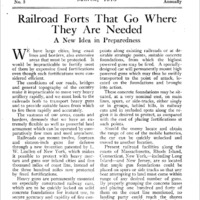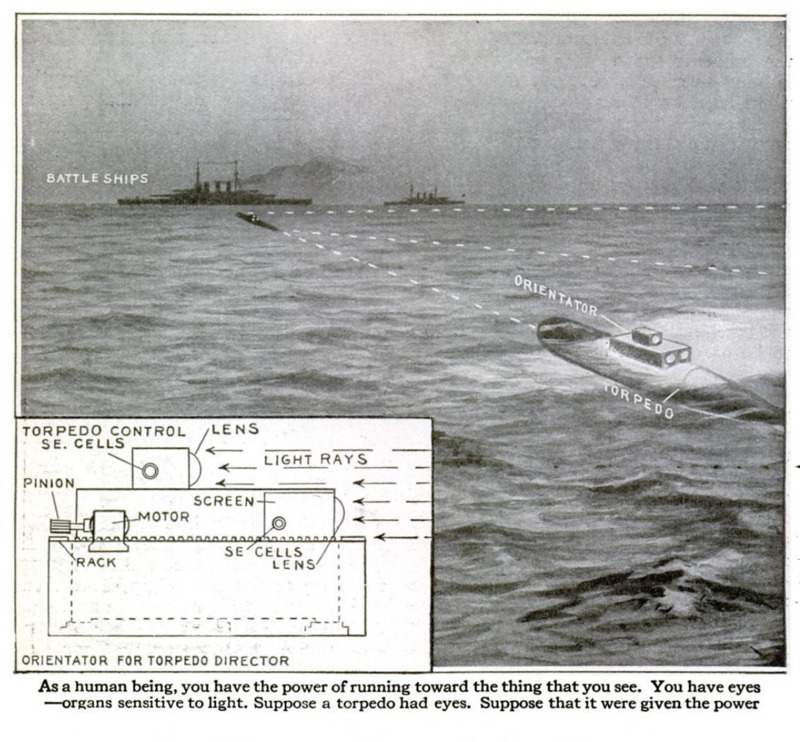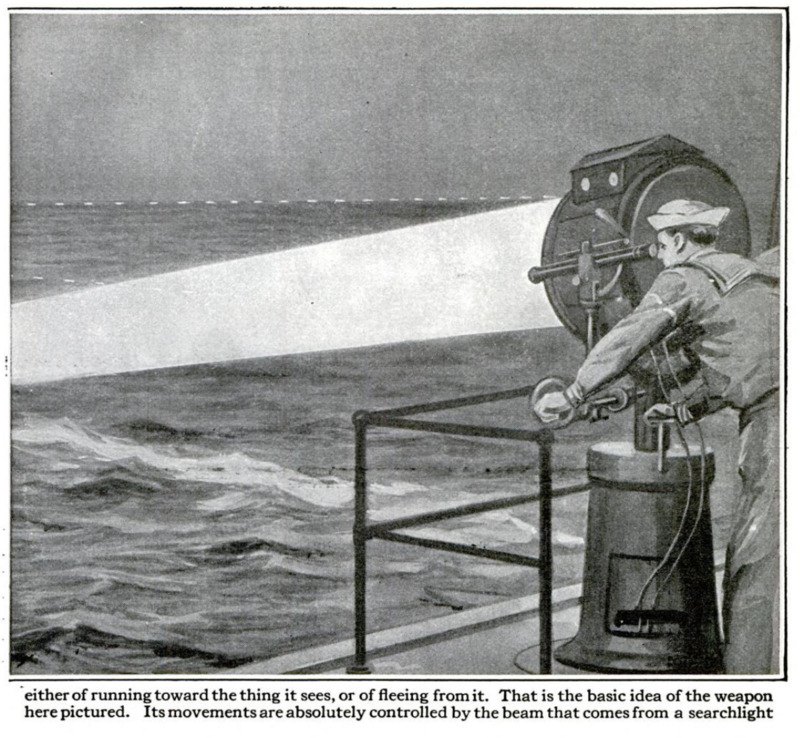A Torpedo with Eyes
Item
-
Title (Dublin Core)
-
A Torpedo with Eyes
-
Article Title and/or Image Caption (Dublin Core)
-
A Torpedo with Eyes
-
extracted text (Extract Text)
-
SUPPOSE we have at our command
torpedoes that obey the orders of a
single master; torpedoes that heed
faithfully the wish of an operator ex-
pressed through a simple directing ap-
paratus; torpedoes that can be projected
six or eight miles through the water, be-
ing constantly under the control of the
man and his machine on shore; in a
word, torpedoes which carry out the in-
tention of one man to destroy an oncom-
ing vessel of the enemy. This torpedo
would simply be the projection mechan-
ically, of this man’s will to destroy that
vessel.
Theoretically, we have the materials
at hand to render this achievement pos-
sible. In fact, the “light-directed tor-
pedo,” as it is called, is virtually on the
threshold of reality, but it has not yet
crossed the threshold. This delay is
caused by the present unreliability of a
chemical substance, selenium, and it is
upon selenium that the eventual success
of the light-directed torpedo depends. In
an article on the Hammond electric dog,
appearing elsewhere in this issue, will
be found an explanation of the way in
which selenium does the work.
A boat has been directed wirelessly
from shore—most all of us have read of
that—and a boat can be directed by wire~
less from shore now; can be made to |
stop, start, stop and swerve to right and
left. Nevertheless, the secret of a re-
liable, light-controlled torpedo — for
light-rays are more desirable than wire-
less—has not yet been entirely solved. |
John Hayes Hammond, Jr., who has
been widely heralded for his wireless ex-
periments, joined hands not long ago |
with B. F. Meissner, an electrical engi-
neering student of Purdue University,
and together they designed and -con-
structed an ingenious mechanism on
wheels that would trail after a pocket
lamp held before its selenium eyes in a
most uncanny way. Using this same
principle, a torpedo with selenium eyes
that will follow the directions of light
rays from shore, will eventually be de-
veloped ; soon, it is to be hoped. |
There have been two big obstacles to
prevent the evolution of a controllable
torpedo: :
One is the lack of a suitable appa-
ratus for transmitting sufficient light
to control the mechanism at useful dis-
tances; the other is to accomplish the
directing without interference from the |
enemy’s ship. The solution of the prob-
lem demands a more scientific knowledge
of selenium and its chemical properties.
Suppose that day had come and a hos- |
tile ship was booming into the harbor of
New York, grimly determined to scatter |
our fair buildings to the four winds.
“Sic!” says the man on shore.
Almost with human intelligence, the |
glistening steel cylinder darts out to- |
wards the enemy, at a forty-mile-an-hour
clip. Though at present such an occur-
rence is only a fancy, it may become
a reality. |
-
Contributor (Dublin Core)
-
Walter Bannard (writer)
-
Language (Dublin Core)
-
eng
-
Date Issued (Dublin Core)
-
1916-03
-
pages (Bibliographic Ontology)
-
424-425
-
Rights (Dublin Core)
-
Public Domain (Google digitized)
-
Archived by (Dublin Core)
-
Filippo Valle
-
Alberto Bordignon (Supervisor)
 Popular Science Monthly, v. 88, n. 3, 1916
Popular Science Monthly, v. 88, n. 3, 1916





